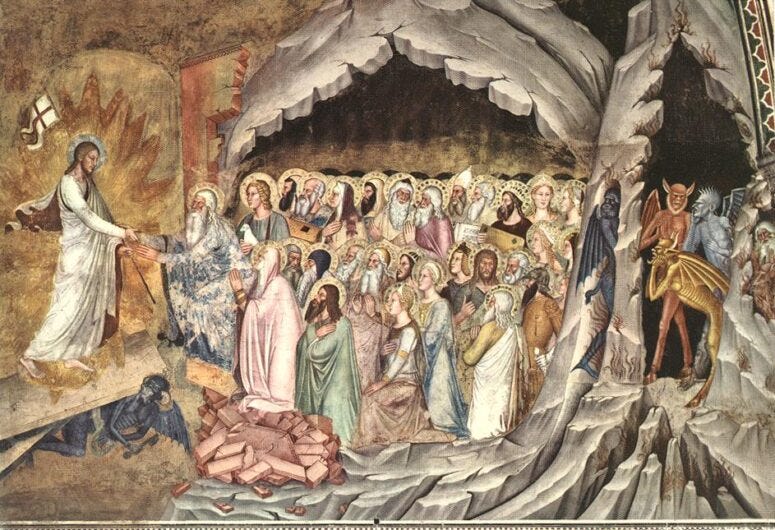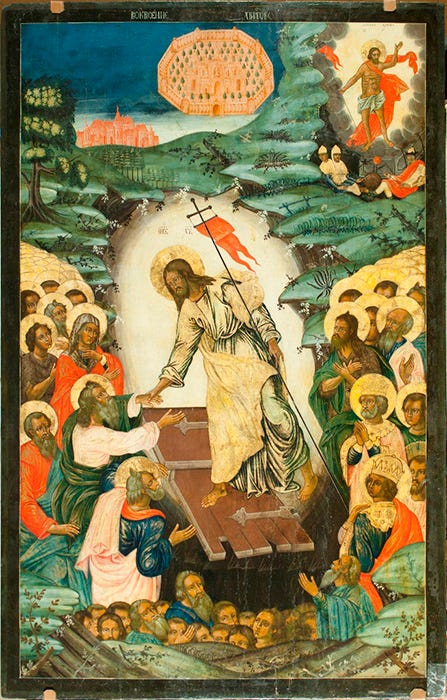The Harrowing of Hell in Middle Earth
How J.R.R. Tolkien Depicts Christ's Victory over Death in The Lord of the Rings

In our last post, we explored how 🦁 C.S. Lewis depicted the harrowing of Hell in The Chronicles of Narnia. Today, we are going to explore how 🧙♂️ J.R.R. Tolkien depicted this doctrine in The Lord of the Rings. You can also explore my most recent 🎥 video and article on the topic of Christ’s descent into Hades (sheol, the realm of the dead) in order to set the captives free.
Tolkien on the Harrowing of Hell
Throughout his letters and literary works, J.R.R. Tolkien was deeply influenced by his liturgical experience of the Mass. One example comes from the Exultet, which is a beautiful hymn chanted in the Easter Vigil:
“This is the night, when Christ broke the prison-bars of death and rose victorious from the underworld (infernem, hades, sheol). Our birth would have been no gain, had we not been redeemed.”
Tolkien would have not only heard these words of Christ’s descent into the realm of the dead on Easter, but he would have also believed this doctrine as taught by the historic Christian church.

He also embeds this doctrine into the underworld of Middle Earth. Although ‘The Lord of the Rings’ is not an allegorical work (compared to Narnia where Aslan is Christ), it certainly has many Christian allusions and references, which we will see in regards to the harrowing of hell.
Let’s explore four different examples from Middle Earth:
In The Fellowship of the Ring, the 9 companions descend into the mines of Moria in order to continue their journey in a more hidden fashion. Unfortunately, it has been overrun by the enemy and has become a type of tomb or even realm for the dead (hades, sheol). It is here that Gandalf confronts one of his darkest foes, a Balrog, which is a flaming, dragon-like beast. Together they fall and descend even further into the belly of the earth where the grey pilgrim eventually defeats this demon of the underworld. I personally love how the movie captures Gandalf and the Balrog falling into the waters of an underground cavern, (see video clip below) which is certainly ancient imagery for Sheol in the Old Testament. Because of Gandalf’s ‘harrowing of hell’ and slaying of the dragon, the fellowship is freed from the prison of Moria and are able to continue their mission.
In The Return of the King, King Aragorn is destined to enter into a forbidden
mountain where only the dead can dwell. It is here that he meets the dead men of Dunharrow and dialogues with the king of the dead. The tale has purgatorial themes that go beyond this post, but suffice to say, King Aragorn leads the deceased out of the mountain where they are eventually freed after fulfilling their allegiance to him. (What is key to the story is that these men were not ‘allies of the Dark Lord nor mortal enemies of the King.’ Before they died, they rejected their original allegiance to Sauron and committed themselves to the King of Gondor. However, after dying, they were delayed in the mountain, because they did not fulfill their allegiance to the king when he called them to fight for the kingdom. They now have the opportunity to fulfill their allegiance to a later King of Gondor, and they follow suit. Their spirits then enter a state of rest and peace.) When Aragorn leads the dead out of the grave (sheol) and into the sunlight, he “blows a horn and unfurls a royal banner.”1 In an earlier draft of the novel, the people “acclaim him as a king risen from the dead,” which Tolkien later repackages as simply “the King of the Dead.” All of Tolkien’s imagery is closely associated with Western Christian art where Christ arises out of the tomb with a victory banner and those he has freed from hades.

Christ leads the righteous out of the harrowing of hell. Fresco, Church Santa-Maria-Novella, Florence, 14th century. 
“In approximately the 17th century, the tradition to depict Christ with a banner was adopted in Russian Orthodox iconography and church architecture” for a time.) (source) Another example of “hell’s harrowing” occurs in the background to Middle Earth in The Simillarion. Tolkien describes the Valar throwing down “Morgoth’s fortress of Angband (the hells of iron) and the Satan-figure has been defeated, a multitude come out of the deep prisons into a changed world.” (See the terrific book, ‘Tolkien Dogmatics’ by Austin Freeman, pg. 253).
Lastly, we see a significant example of this doctrine with the destruction of the Ring and the final defeat of Mordor at the end of the novel. Gandalf conceives of a plan to deceive Sauron by essentially drawing out his troops to overwhelm the King of Gondor and his company in order to buy Frodo and Sam time. Sauron takes the bait knowing that he will likely win against such a small army along with the victory prizes of a dead Gandalf, King Aragorn, and even hobbits who may have the ring. The ‘deception’ works; the Dark Lord is finally defeated, and the peoples of Middle Earth are freed from his ‘shadow of death.’
Some of the fathers will talk of Satan being deceived by Christ at his death and descent in hades. Satan could not help but kill and consume Christ since his nature desires death and destruction for everyone. However, this was no ordinary man, and the divinity of Christ burst open the ‘belly of the beast.’ Death and hades spit Him out along with all those who belonged to Him. This is called the ‘fish hook’ theory which is closely associated with the Ransom and Christus Victor models for the atonement.
St. Gregory of Nyssa in his Great Catechism (24) describes it this way:
“[I]t was not in the nature of the opposing power to come in contact with the undiluted presence of God, and to undergo His unclouded manifestation, therefore, in order to secure that the ransom in our behalf might be easily accepted by him who required it, the Deity was hidden under the veil of our nature, that so, as with ravenous fish, the hook of the Deity might be gulped down along with the bait of flesh, and thus, life being introduced into the house of death, and light shining in darkness, that which is diametrically opposed to light and life might vanish; for it is not in the nature of darkness to remain when light is present, or of death to exist when life is active.”
St. John Damascene also adds in his Exposition of the Orthodox Faith (3.27):
“Since our Lord Jesus Christ was without sin (for He committed no sin, He Who took away the sin of the world, nor was there any deceit found in His mouth ) He was not subject to death, since death came into the world through sin. Rom. 5:12 He dies, therefore, because He took on Himself death on our behalf, and He makes Himself an offering to the Father for our sakes. For we had sinned against Him, and it was meet that He should receive the ransom for us, and that we should thus be delivered from the condemnation. God forbid that the blood of the Lord should have been offered to the tyrant. Wherefore death approaches, and swallowing up the body as a bait is transfixed on the hook of divinity, and after tasting of a sinless and life-giving body, perishes, and brings up again all whom of old he swallowed up. For just as darkness disappears on the introduction of light, so is death repulsed before the assault of life, and brings life to all, but death to the destroyer.”
To conclude, Satan and Sauron are both defeated because the ‘Good’ was willing to be made weak in order to set captives free.
Thanks be to God!
(See ‘Tolkien Dogmatics’ by Austin Freeman, pg. 253).


